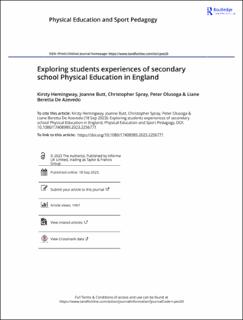| dc.description.abstract | Background: There are many diverging views regarding the role and purpose of Physical Education (PE) in secondary schools within the UK. However, very few studies have explored PE processes through the eyes of young people. Adolescence represents a critical time period when physical activity (PA) behaviour patterns are often established. Student disengagement in PE is therefore a concern, as PE has the potential to play an important role in influencing adolescents to develop lifelong PA habits. Secondary school PE is compulsory in the UK until the age of 16, therefore PE teachers have a captive audience who they can influence positively or negatively. Understanding of students’ experiences and perceptions of PE could help inform future PE provision. Purpose: The purpose of this study was to explore students’ perceptions of PE throughout secondary school (age 11–16) in England, UK. This study aims to explore students’ views concerning changes and continuities from Key Stage (KS3) (age 11–14) to KS4 (age 14–16). We are also interested in the meanings that students attach to their PE experiences, identifying the social structures and processes that shape these meanings. Methods: Using a social constructionist framework, semi-structured interviews were conducted at eight secondary schools across Yorkshire, England. A convenience sample of eligible schools was used to recruit the study participants. Two participants aged 15–16 (Year 11, KS4) were interviewed at each school (N = 16). Inductive and deductive thematic analysis informed by self-determination theory guided the analysis. Thematic analysis comprised three second-order themes which were generated by ten first-order themes drawing students’ experiences of PE. Results: Perceptions of PE throughout KS3 (age 11–14) were perceived as unfavourable, owing to too much structure and social comparisons. However, perceptions of KS4 (age 14–16) PE lessons were positive, with students enjoying increased choice, less structure, and an opportunity to relieve the stress and pressure of school life. Students identified the role of the teacher to be significant in enhancing student experience throughout secondary school. However, students acknowledged that the student–teacher relationship changed across secondary school, suggesting a need for numerous pedagogical approaches to be adopted through secondary school PE. In addition, PE is recognised by some students as an opportunity to improve their wellbeing, advocating the need for PE teachers to consider employing more holistic outcomes within PE lessons. Conclusions: The findings of this study suggest that there is a noticeable difference between students’ experiences of PE at KS3 (age 11–14) compared to KS4 (age 14–16), questioning if the KS3 curriculum is conducive to support student engagement in PE. The results also indicate that PE teachers could widen the learning of PE beyond the physical domain and incorporate a more holistic approach when planning and delivering PE lessons. The long-term implications of engaging more students in PE is that we may inspire more adolescents to remain physically active into adulthood, and to live healthier, more active lives. | |

